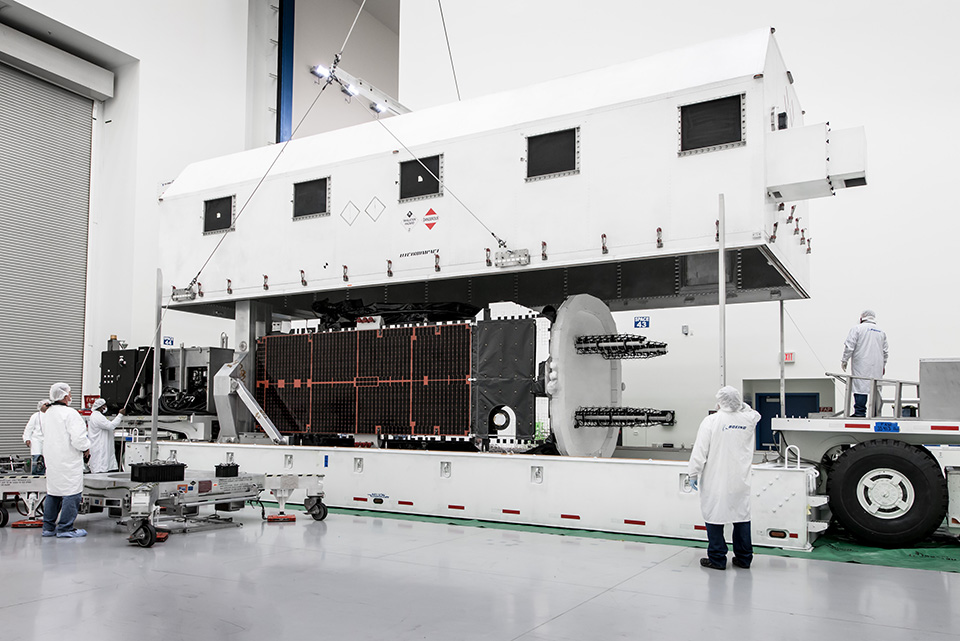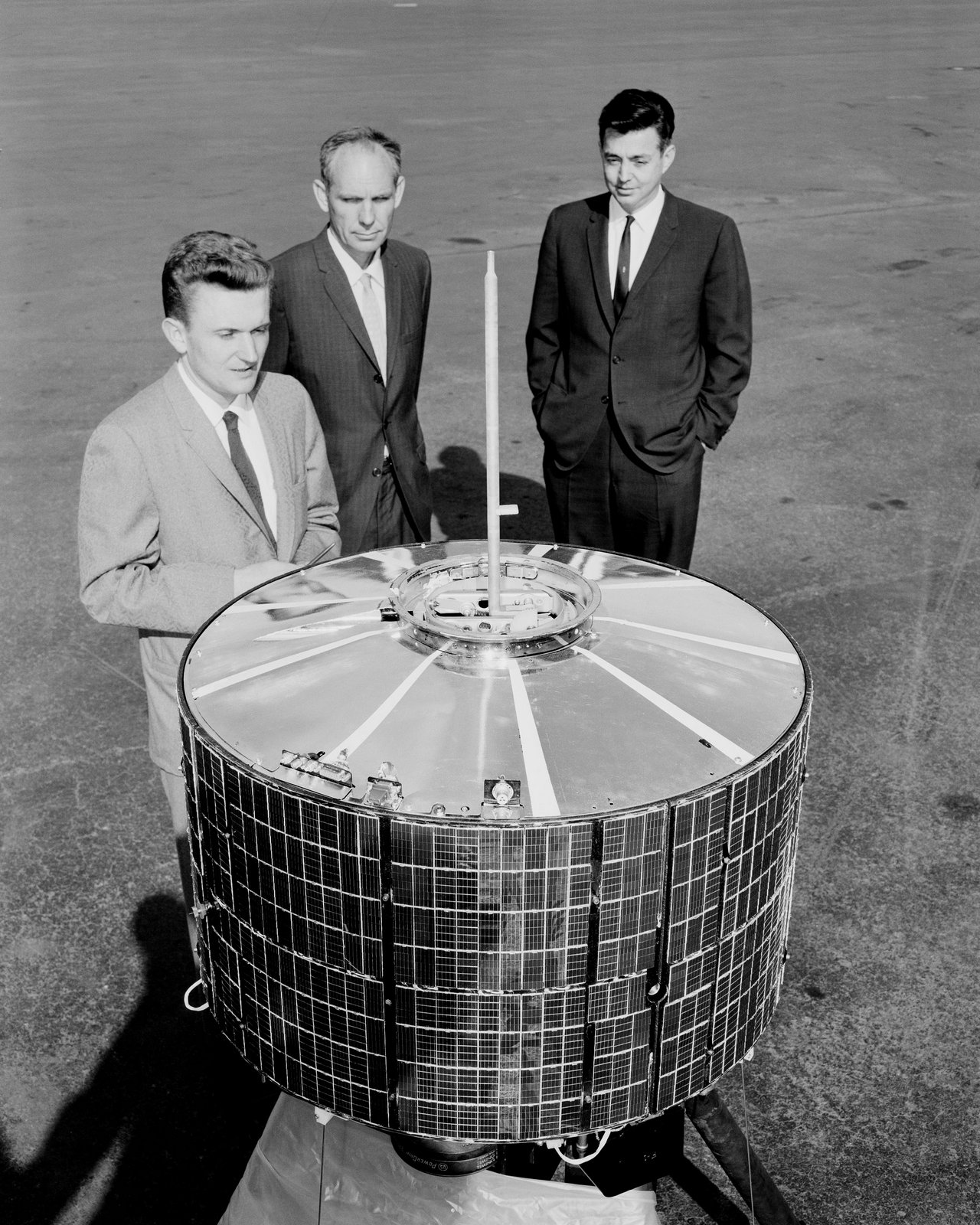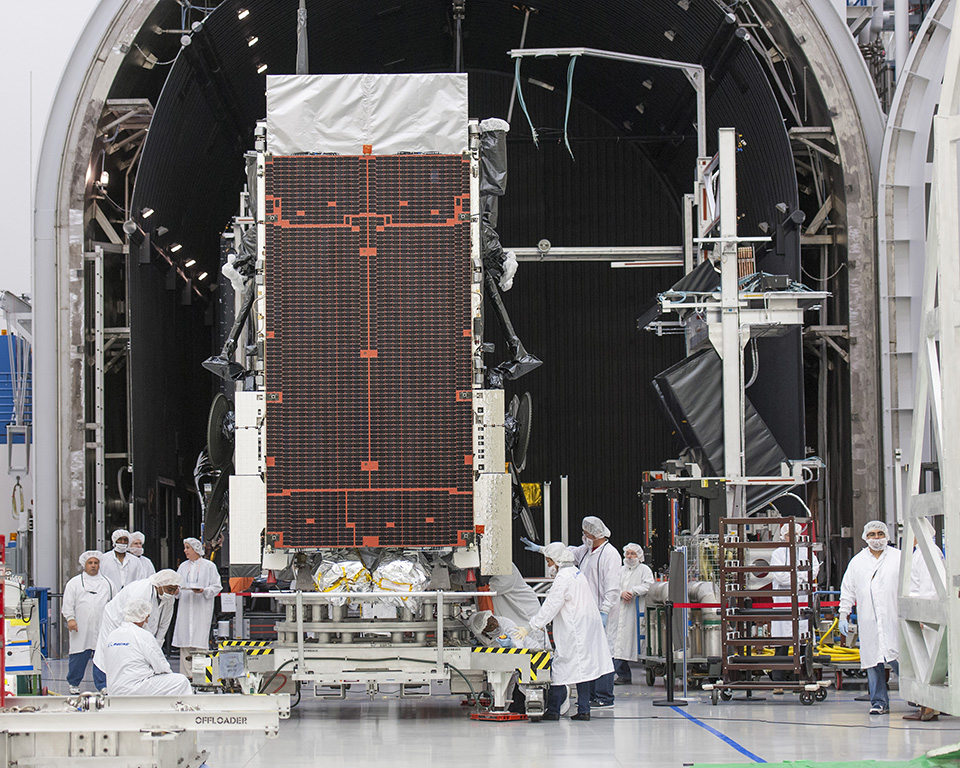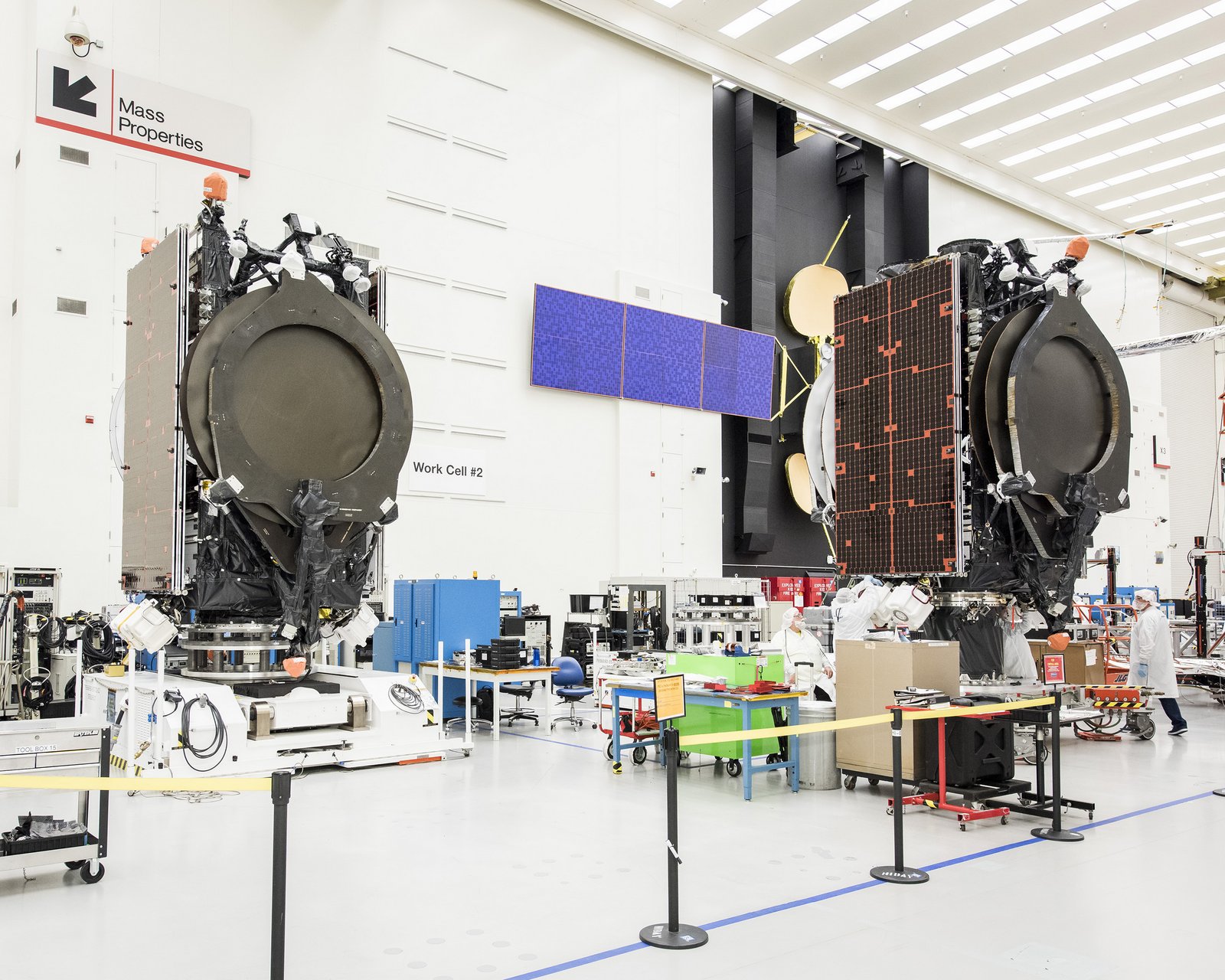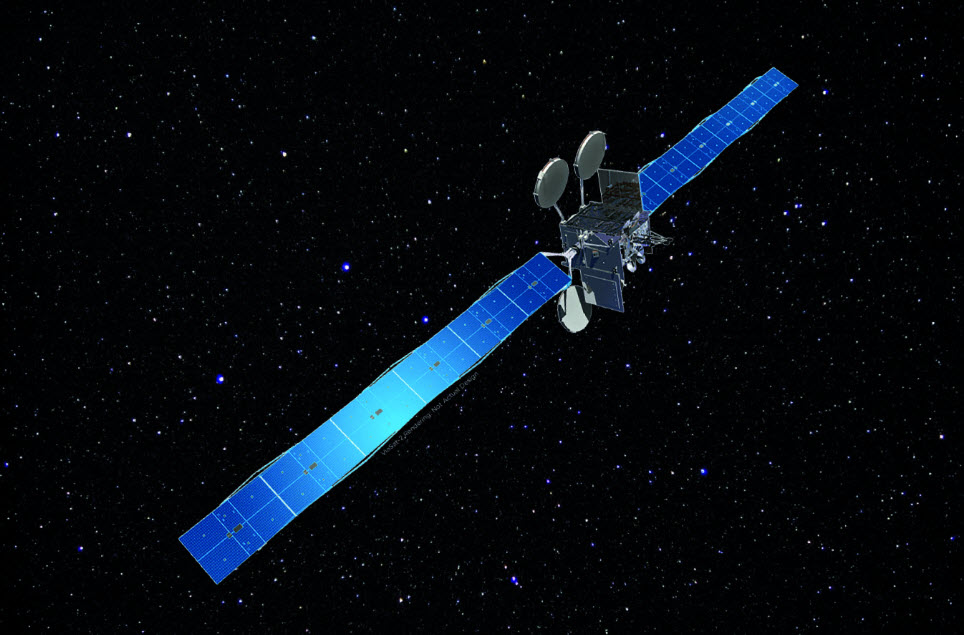
If you could see it, 22,000 miles in space, this is what ViaSat-2 might look like. Image: ViaSat/NASA
Written for the Airline Passenger Experience Association’s APEX Experience Magazine – Issue 7.2
ViaSat-2 sat quietly on its cradle in the clean room, no longer attended to by scores of gowned technicians. Antennas folded, solar panels and radiators tightly retracted. Its large rectangular structure could have been mistaken for an industrial appliance, rather than a highly advanced communications satellite bound for space.
The satellite was ready to be enclosed in a specialized shipping container, a cocoon, to protect the satellite during its flight to French Guiana. And soon after being launched on an Ariane 5, ViaSat-2 will stretch out its 158-foot-long solar panels, ushering in new capabilities of Ka-band connectivity.
Using its conventional chemical, and low-power electric thrusters, the hybrid-propulsion satellite will take months to reach its geostationary orbital slot, 22,236 miles above the equator, roughly in line with the US East Coast. Expected to be operational by the end of 2017, ViaSat-2 will more than double the capacity of ViaSat-1, the company’s first purpose-built satellite.
The new bird is expected to have about 300 gigabits per second (Gbps) bandwidth, with seven times more coverage than ViaSat-1. That footprint covers virtually all of North America, the Caribbean and Central America, and the northern part of South America. ViaSat-2 will also cover the North Atlantic, ensuring connectivity for passengers on intercontinental flights.
Bridging the ocean
“It creates a bridge over the Atlantic that allows commercial airliners to travel from the West Coast of the US all the way through Europe and into the Middle East, with a seamless handover between our satellite and our partner Eutelsat’s KA-SAT satellite,” says David Abrahamian, director, space systems, for ViaSat.
ViaSat currently provides in-flight connectivity for nearly 550 aircraft that are flying with United, JetBlue, Virgin America and EL AL Israel Airlines. The company was recently awarded contracts with Finnair, SAS, El Al and Qantas. American Airlines has also chosen ViaSat for its new Boeing 737MAXs, and has announced plans to retrofit more than 500 aircraft from its existing, mainline domestic fleet with the ViaSat in-flight internet system.
With nearly 700,000 terrestrial residential and consumer customers, in-flight connectivity accounts for only 5-6% of ViaSat’s available bandwidth, according to Keven Lippert, the company’s executive vice-president, corporate development. “A few years ago, the airline business was a startup within ViaSat. ViaSat-2 will continue to grow the airline business, but the unknown is how much it’ll grow. It’s more airplanes, and it’s also more connected passengers. We want both,” says Lippert.
ViaSat has a 30-year history as a terrestrial hardware provider for communications networks, but is now making a fundamental change in philosophy. “We’re really evolving toward being what we believe is going to be the first global internet service provider. And that is obviously powered by these incredible satellites – ViaSat-2, and the next-generation ViaSat-3s that we’re working on with Boeing,” says Abrahamian.
Building the Bird
ViaSat partnered with Boeing Satellite Systems for the construction of the soon-to-be launched ViaSat-2. Boeing’s storied El Segundo, California facility has built over 300 satellites, dating back to the early 1960s. Then known as Hughes Space and Communications, the factory manufactured Syncom, the world’s first geostationary satellite. Less than three-feet around and massing just over 70 pounds, the drum-shaped satellite was used to broadcast the 1964 Tokyo Summer Olympics to the United States.
Dwarfing its pioneering ancestor, ViaSat-2 has a mass of over 14,000 pounds, stands more than 20 feet tall, is almost 15 feet wide, and has solar panels that generate 17.5 kilowatts of power. It’s based on Boeing’s mature BSS-702HP platform.
“The satellite comes in three pieces,” explains Ron Dukat, ViaSat-2 program director for Boeing. “Piece number one is the bus module. It’s the piece of the satellite that does all the housekeeping for the vehicle. It keeps it at the right spot on-orbit. It provides power through solar arrays and batteries, and it provides thermal controls.”
With on-orbit temperatures ranging from -300 to +300 Fahrenheit, it’s critical to maintain on-board systems at the right temperature. Remarkably, the satellite keeps most of its components at room temperature using heaters, insulation and radiators.
Testing, Testing…
The second piece is the payload module, holding all the mission-specific electronics. “And then we have the antenna system – we bolt it on and that’s when we begin the testing. It’s a rigorous test program to make sure that [the satellite] is going to work for 15 years. You can’t go and fix it once it’s up there,” says Dukat.
In Boeing’s million-square foot facility, satellites undergo vibration and acoustic testing that mimics the extreme stresses encountered during launch. That’s followed by between 30 and 45 days in a massive thermal vacuum chamber, where the satellite’s electronics are tested in as close to a space environment as can be duplicated on Earth.
A communication satellite’s lifetime is between 10 and 15 years, although about 20% of the 60 Boeing-built commercial satellites now on-orbit have exceeded their service life. “There are two things that limit a satellite’s life,” says Mark Spiwak, president, Boeing Satellite Systems. “First, the amount of fuel onboard, to keep it in position. Then there’s the degradation of the electronics from the space environment.”
A satellite’s components are hardened and shielded to handle the harsh environment of space. In addition to extreme temperatures, a satellite in geostationary orbit has to withstand the equivalent of approximately 220 million chest x-rays a day, according to Spiwak.
Technological advancement is another factor that operators consider when looking to replace their valuable space assets. What might be state-of-the-art when a satellite is launched may very well be surpassed technologically, 10 or 15 years later.
Good Things Come in Threes
But ViaSat won’t be waiting that long to advance on-orbit technology. Just two years from now, in 2019, the company is planning to launch its first two ViaSat-3 class satellites. ViaSat will design and build the payload module, and has contracted Boeing for the satellites’ buses.
With hemispheric footprints, three satellites will eventually provide overlapping global coverage. Each of the ViaSat-3 satellites will have more bandwidth capability than all of the 400 communications satellites now in space and will be the world’s first 1,000 Gbps – 1 terabit per second – satellites
“What matters is how much capacity is in the system,” says ViaSat’s Lippert. “The math is simple – if every passenger on every connected airplane uses their devices, how much capacity do I need in my network? We’re planning to take 100s of gigabits and use them for the airlines, and 100s for the consumer business. We believe that there’s a huge market, and that’s why we’re building these global terabit satellites.”
